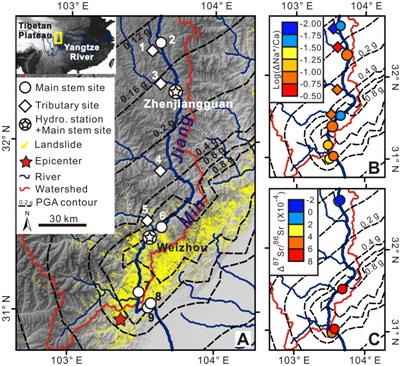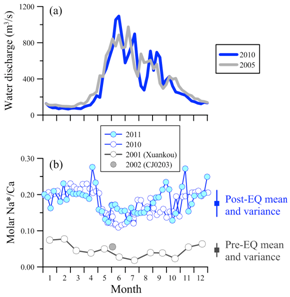Weathering of silicate minerals produces Ca and Mg alkalinity that removes carbon from the atmosphere-ocean system during carbonate formation. Changes in Earth’s weathering system have been invoked as a possible explanation for global cooling over the past ~40 million years, leading to the planet’s present climate state. One hypothesis is that increases in weathering were driven by tectonic activity. Connections between tectonism and silicate weathering rates and fluxes have been debated on the basis of indirect evidence from the geologic records and from present-day weathering systems, but mechanistic understanding of these links has remained elusive.
Riverine solute chemistry integrates geochemical processes and regulates global biogeochemical cycles. By triggering landslides, fracturing rock, changing permeability, and influencing hydrologic pathways, earthquakes alter geochemical processes of the river systems, so large earthquakes may directly link tectonic activity and chemical fluxes. But this link has yet to be clearly observed because of their infrequency, even though their cumulative effects may be significant over the centennial or longer timescales. The chemical response of the Min Jiang to the 2008 Mw 7.9 Wenchuan earthquake provides a rare opportunity, for the first time allowing to directly observe and quantify how a tectonic event affects weathering-driven CO2 drawdown and associated chemical signatures, including the isotopic composition of dissolved Sr, which carries information about sources of dissolved ions from weathering. The Wenchuan opportunity arises in part because of significant existing data on Min Jiang river chemistry prior to 2008, providing direct comparison with samples collected after the earthquake.

Fig. 1 Map of the Wenchuan earthquake region along the eastern Tibetan Plateau, showing the magnitudes of observed change in Na*/Ca and 87Sr/86Sr relative to prior to the earthquake, along with the river network and PGA contours.(Image by JIN Zhangdong,et al)
In a latest online scientific paper in the journal Geology (Seismically enhanced solute fluxes in the Yangtze River headwaters following the A.D. 2008 Wenchuan earthquake), a significant shift in the dissolved chemistry of the Min Jiang, in the Yangtze River headwaters, following the 2008 Mw 7.9 Wenchuan earthquake was demonstrated. The fluxes of dissolved ions from silicate sources increased after the earthquake, accompanied by a ~4x increase in Na*/Ca ratios (where Na* is Na+ corrected for atmospheric and evaporite contributions) and a 0.000644 ± 0.000146 increase in 87Sr/86Sr isotopic ratios. The results infer that the CO2 consumption rate via silicate-derived alkalinity increased 4.3 ± 0.4 times. These changes are consistent with enhanced contribution from silicate sources.

Fig.2 A systematic shift of Min Jiang riverine Na*/Ca ratios after the 2008 Wenchuan earthquake relative to pre-earthquake (EQ) data, along with river water discharge.(Image by JIN Zhangdong et al.)
By combining with the correlation peak ground acceleration (PGA) and co-seismic landslide density with Na*/Ca and 87Sr/86Sr ratios, the enhanced silicate-derived alkalinity and fluxes would stem from the contribution from hydrological processes versus enhanced dissolution in landslide debris and along fractures, and to some extent these effects may be coupled. At the end of the paper, the authors pointed out that whether other earthquakes cause similar effects might relate to a number of factors. These questions will only be answered by further investigation to explore how the magnitude and duration of change vary for different earthquakes, and to understand the underlying mechanisms causing observed changes. However, if similar changes are associated with other large earthquakes, enhanced solute export could directly link tectonic activity with weathering and alkalinity fluxes and seawater Sr evolution. This case study provides further insight into the relationship among tectonic activity, weathering and global climate change.
This is the second Geology paper after “Controls on fluvial evacuation of sediment from earthquake-triggered landslides (Geology, 2015, 43(2): 115-118 by the same team. This international team is led by professor JIN Zhangdong at Institute of Earth Environment, Chinese Academy of Sciences, the team members including Dr. WEST Joshua at University of Southern California, Dr. HILTON Robert at Durham University, YU Jimin at The Australian National University, and his six institute colleagues. This work was funded by 973 Program, NSFC, U.S. NSF, and CAS.
Contact: Dr JIN Zhangdong: zhdjin@ieecas.cn,
State Key Laboratory of Loess and Quaternary Geology, Institute of Earth Environment, CAS (http://english.ieecas.cn/).
 © 2015 Institute of Earth Environment,CAS
© 2015 Institute of Earth Environment,CAS Address:No. 97 Yanxiang Road, Xi'an 710061, Shaanxi, China

 Location :
Location :